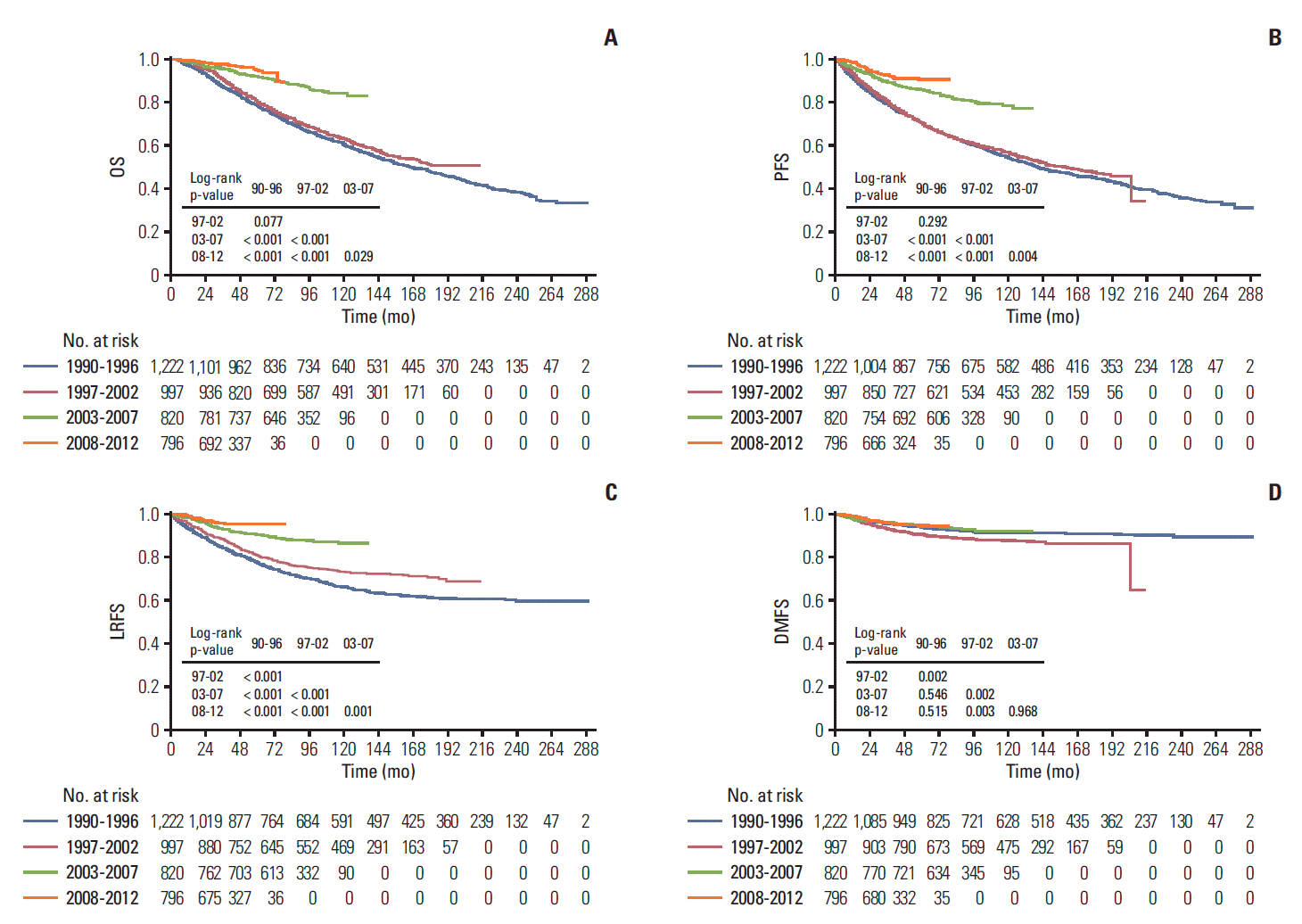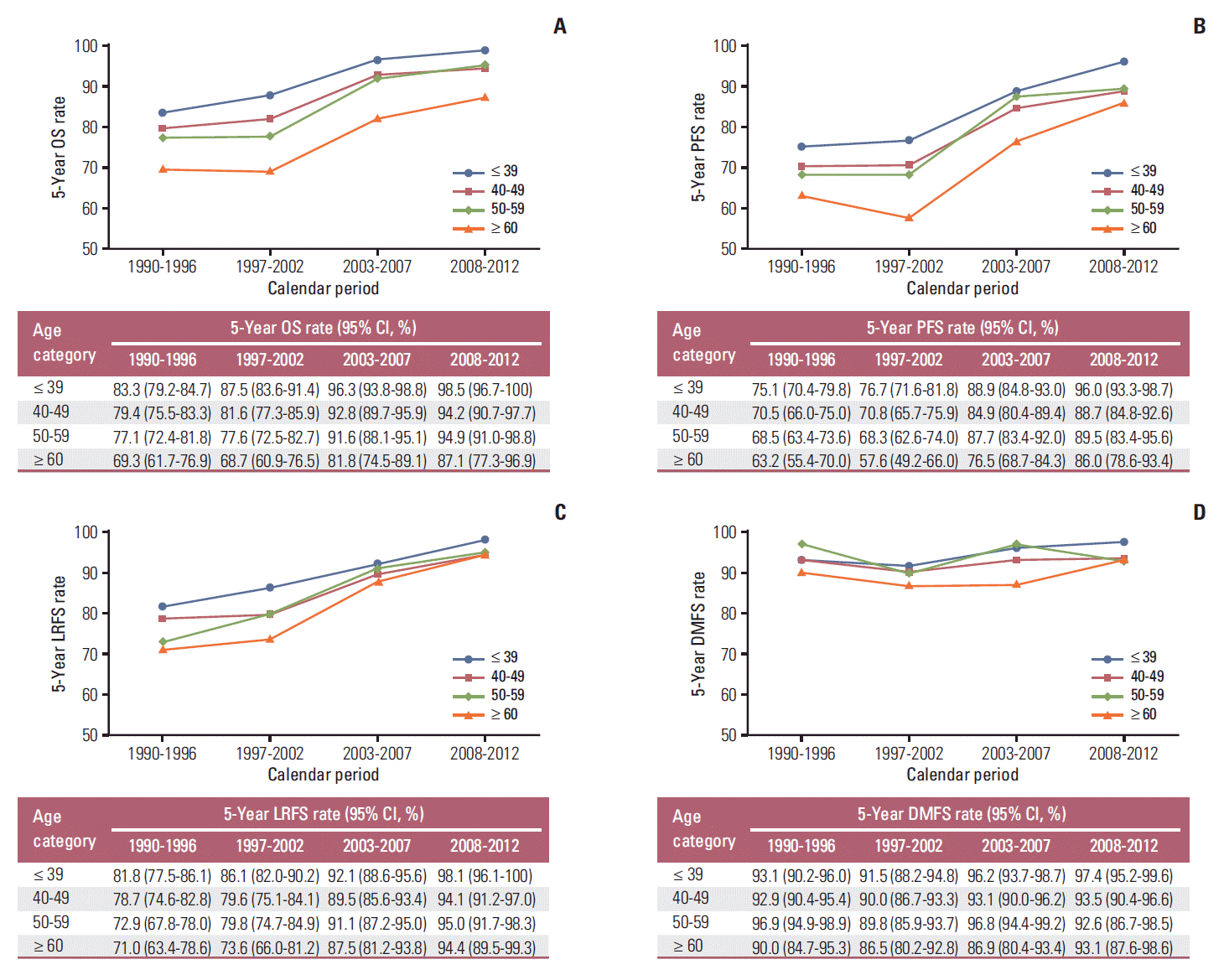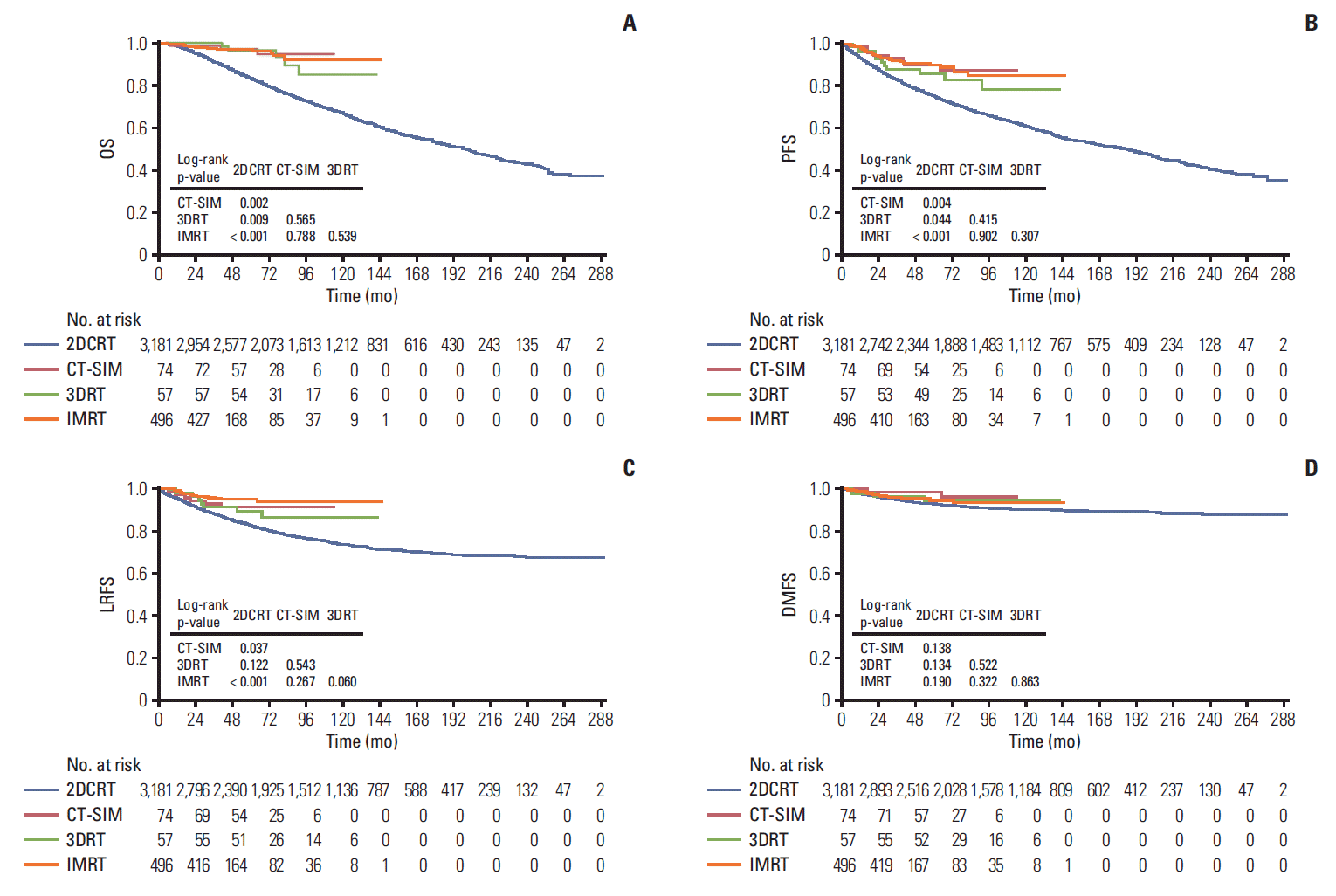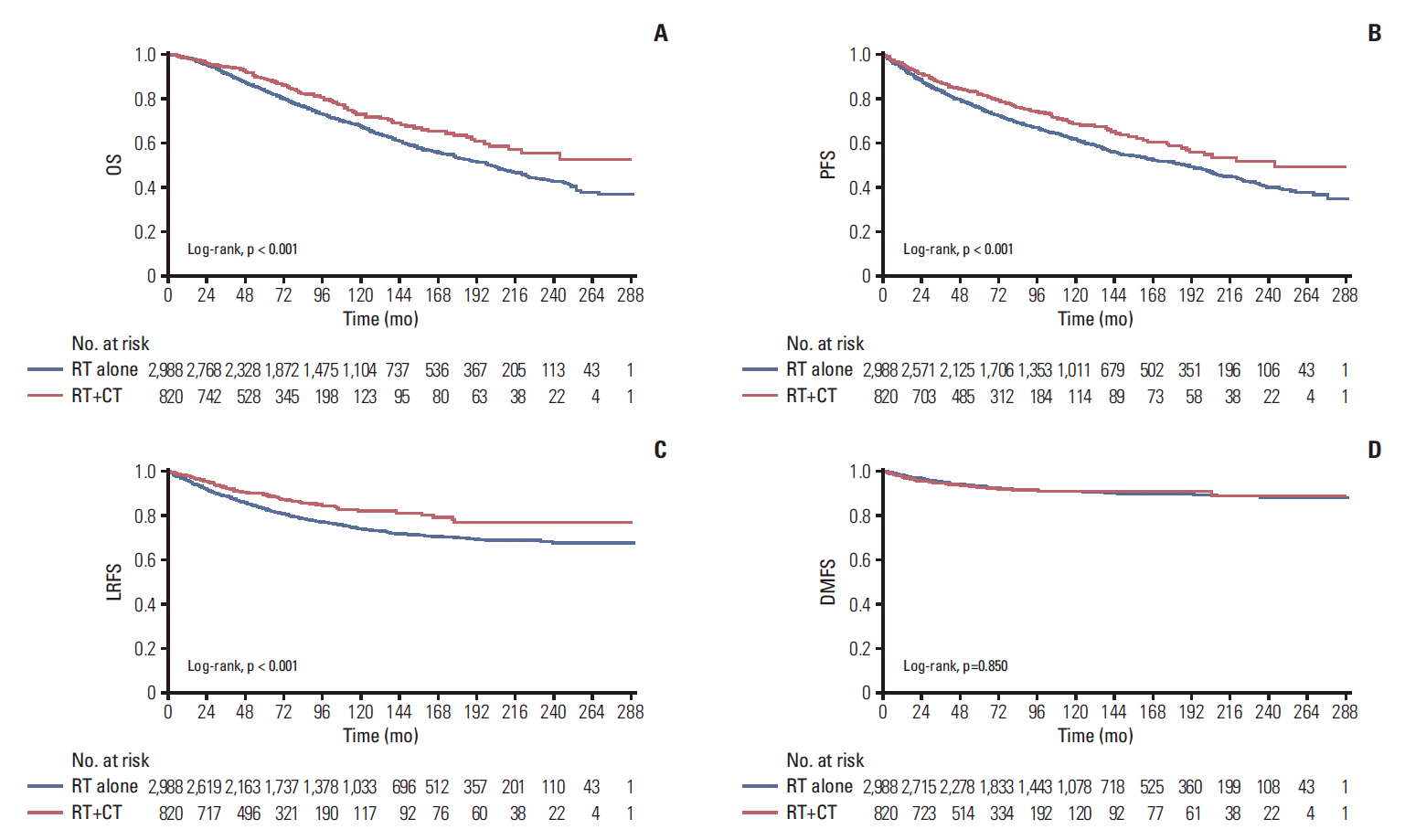Abstract
Purpose
Materials and Methods
Results
ACKNOWLEDGMENTS
References
Fig. 1.

Fig. 2.

Fig. 3.

Fig. 4.

Fig. 5.

Table 1.
| Characteristic | Total | 1990-1996 | 1997-2002 | 2003-2007 | 2008-2012 | p-value |
|---|---|---|---|---|---|---|
| Age (yr) | ||||||
| ≤ 39 | 1,038 (27.3) | 327 (28.2) | 281 (28.2) | 221 (27.0) | 209 (27.2) | 0.325 |
| 40-49 | 1,278 (33.6) | 423 (34.6) | 321 (32.2) | 255 (31.1) | 279 (36.3) | |
| 50-59 | 990 (26.0) | 323 (26.4) | 258 (25.9) | 232 (28.3) | 177 (23.0) | |
| ≥ 60 | 502 (13.2) | 149 (12.2) | 137 (13.7) | 1,112 (13.7) | 104 (13.5) | |
| Sex | ||||||
| Female | 1,078 (28.3) | 348 (28.5) | 292 (29.3) | 211 (25.7) | 227 (29.5) | 0.293 |
| Male | 2,730 (71.7) | 874 (71.5) | 705 (70.7) | 609 (74.3) | 542 (70.5) | |
| T category | ||||||
| T1 | 659 (17.3) | 220 (18.0) | 139 (13.9) | 138 (16.8) | 162 (21.1) | 0.001 |
| T2 | 3,149 (82.7) | 1,002 (82.0) | 858 (86.1) | 682 (83.2) | 607 (78.9) | |
| N category | ||||||
| N0 | 1,364 (35.8) | 453 (37.1) | 400 (40.1) | 280 (34.1) | 231 (30.0) | < 0.001 |
| N1 | 2,444 (64.2) | 796 (62.9) | 597 (59.9) | 540 (65.9) | 538 (70.0) | |
| Radiotherapy technique | ||||||
| 2DCRT | 3,181 (83.5) | 1,222 (100) | 981 (98.4) | 680 (82.9) | 298 (38.8) | < 0.001 |
| CT-SIMa) | 74 (1.9) | 0 | 0 | 33 (4.0) | 41 (5.3) | |
| 3DRT | 57 (1.5) | 0 | 8 (0.8) | 22 (2.7) | 27 (3.5) | |
| IMRT | 496 (13) | 0 | 8 (0.8) | 85 (10.4) | 403 (52.4) | |
| Image technique | ||||||
| CT | 2,319 (60.9) | 1,222 (100) | 939 (94.2) | 151 (18.4) | 7 (0.9) | < 0.001 |
| MRI | 1,356 (35.6) | 0 | 58 (5.8) | 638 (77.8) | 660 (85.8) | |
| PET-CT+MRI | 133 (3.5) | 0 | 0 | 31 (3.8) | 102 (13.3) | |
| Type of treatment | ||||||
| RT | 2,988 (78.5) | 1,084 (88.7) | 925 (92.8) | 587 (71.6) | 392 (51.0) | < 0.001 |
| CRT | 820 (21.5) | 138 (11.3) | 72 (7.2) | 233 (28.4) | 377 (49.0) | |
| VCA-IgAb) | ||||||
| ≥ 1:160 | 1,776 (50.3) | 606 (57.5) | 554 (60.5) | 333 (42.0) | 283 (36.8) | < 0.001 |
| < 1:160 | 1,754 (49.7) | 447 (42.5) | 362 (39.5) | 460 (58.0) | 485 (63.2) | |
| EA-IgAb) | ||||||
| ≥ 1:10 | 2,299 (65.1) | 586 (55.7) | 678 (74.0) | 565 (71.2) | 470 (61.2) | < 0.001 |
| < 1:10 | 1,231 (34.9) | 467 (44.3) | 238 (26.0) | 228 (28.8) | 298 (38.8) | |
| Smoking | ||||||
| No | 2,211 (58.1) | 648 (53.0) | 588 (59.0) | 468 (57.1) | 507 (65.9) | < 0.001 |
| Yes | 1,597 (41.9) | 574 (47.0) | 409 (41.0) | 352 (42.9) | 262 (34.1) | |
| Diabetes mellitus | ||||||
| No | 3,722 (97.7) | 1,217 (99.6) | 990 (99.3) | 797 (97.2) | 718 (93.4) | < 0.001 |
| Yes | 86 (2.3) | 5 (0.4) | 7 (0.7) | 23 (2.8) | 51 (6.6) | |
| Family history of NPC | ||||||
| No | 3,385 (88.9) | 1,138 (93.1) | 875 (87.8) | 706 (86.1) | 666 (86.6) | < 0.001 |
| Yes | 423 (11.1) | 84 (6.9) | 122 (12.2) | 114 (13.9) | 103 (13.4) | |
| Total | 3,808 (100) | 1,222 (32.1) | 997 (26.2) | 820 (21.5) | 769 (20.2) |
Values are presented as number (%). p-value was calculated with the Pearson chi-square test. 2DCRT, two-dimensional conventional radiotherapy; CT-SIM, computed tomography simulator; 3DRT, three-dimensional conformal radiotherapy; IMRT, intensity-modulated radiotherapy; CT, computed tomography; MRI, magnetic resonance imaging; PET, positron emission computer tomography; RT, radiotherapy; CRT, chemoradiotherapy; VCA, viral capsid antigen; EA, early antigen; NPC, nasopharyngeal carcinoma.
Table 2.
Table 3.
Table 4.
Table 5.
A Cox proportional hazards regression model was used to detect variables. All variables were transformed into categorical variables. HRs were calculated for age (yr) (≥ 60 vs. 50-59 vs. 40-49 vs. ≤ 39); sex (male vs. female); T category (II vs. I); N category (I vs. 0); smoking (yes vs. no); diabetes mellitus (yes vs. no); family history of NPC (yes vs. no); type of treatment (CRT vs. RT); and radiotherapy technique (IMRT vs. 3DRT vs. CT-SIM vs. 2DCRT). NPC, nasopharyngeal carcinoma; HR, hazard ratio; CI, confidence interval; CRT, chemoradiotherapy; RT, radiotherapy; IMRT, intensity-modulated radiotherapy; 3DRT, three-dimensional conformal radiotherapy; CT-SIM, computed tomography simulator; 2DCRT, two-dimensional conventional radiotherapy.




 PDF
PDF Citation
Citation Print
Print


 XML Download
XML Download